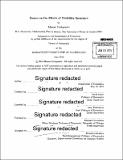| dc.contributor.advisor | David Autor, Amy Finkelstein and Michael Greenstone. | en_US |
| dc.contributor.author | Deshpande, Manasi | en_US |
| dc.contributor.other | Massachusetts Institute of Technology. Department of Economics. | en_US |
| dc.date.accessioned | 2015-09-17T19:06:06Z | |
| dc.date.available | 2015-09-17T19:06:06Z | |
| dc.date.copyright | 2015 | en_US |
| dc.date.issued | 2015 | en_US |
| dc.identifier.uri | http://hdl.handle.net/1721.1/98703 | |
| dc.description | Thesis: Ph. D., Massachusetts Institute of Technology, Department of Economics, 2015. | en_US |
| dc.description | Cataloged from PDF version of thesis. | en_US |
| dc.description | Includes bibliographical references. | en_US |
| dc.description.abstract | I study the effects of disability insurance receipt on the long-term outcomes of children and their families. I use data from the Social Security Administration on children enrolled in the Supplemental Security Income (SSI) program and their family members. In Chapter 1, I estimate the long-term effects of removing low-income youth with disabilities from SSI on the level and variance of their earnings and income in adulthood. Using a regression discontinuity design based on a change in the likelihood of removal at age 18, I find that SSI youth who are removed earn on average $4,000 per year in adulthood and recover only one-third of their lost SSI payment. They experience a present discounted income loss of $73,000 over the 16 years following removal. In addition, the within person variance of income quadruples as a result of removal. Under various assumptions, I find that up to one-quarter of the recipient's welfare loss from SSI removal is attributable to the increase in income volatility rather than to the fall in income levels. This result suggests that ignoring the income stabilization effects of disability programs could underestimate their value to recipients. Chapter 2 examines the effects of removing children from SSI before age 18, prior to the completion of education decisions, on their earnings in adulthood. Using variation in child medical reviews, I find no evidence of a difference in earnings between SSI children who are removed at a young age versus those who stay on, though the estimates are imprecise. I provide suggestive evidence on the channels through which early-life removal affects adult outcomes by studying effects on younger siblings. Using the empirical strategy from Chapter 1, I find that removing an 18-year-old decreases the adult earnings of younger siblings by $3,100 per year. In Chapter 3, I estimate the effects of removing young children with disabilities from SSI on parental earnings and household income, using the child medical review empirical strategy from Chapter 2. I find that parents fully offset the SSI loss with increased earnings. The child's removal also discourages parents and siblings from applying for disability insurance themselves. | en_US |
| dc.description.statementofresponsibility | by Manasi Deshpande. | en_US |
| dc.description.tableofcontents | Chapter 1. Chapter 2. The Chapter 3. The Does welfare inhibit success? : the long-term effects of removing low-income youth from disability insurance -- effects and channels of early-life removal from disability insurance : evidence from Supplemental Security Income children -- effect of disability payments on household earnings and income : evidence from the SSI Children's Program. | en_US |
| dc.format.extent | 188 pages | en_US |
| dc.language.iso | eng | en_US |
| dc.publisher | Massachusetts Institute of Technology | en_US |
| dc.rights | M.I.T. theses are protected by copyright. They may be viewed from this source for any purpose, but reproduction or distribution in any format is prohibited without written permission. See provided URL for inquiries about permission. | en_US |
| dc.rights.uri | http://dspace.mit.edu/handle/1721.1/7582 | en_US |
| dc.subject | Economics. | en_US |
| dc.title | Essays on the effects of disability insurance/ | en_US |
| dc.type | Thesis | en_US |
| dc.description.degree | Ph. D. | en_US |
| dc.contributor.department | Massachusetts Institute of Technology. Department of Economics | |
| dc.identifier.oclc | 920688711 | en_US |
